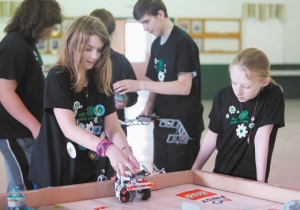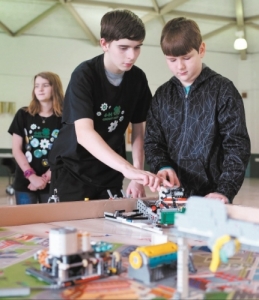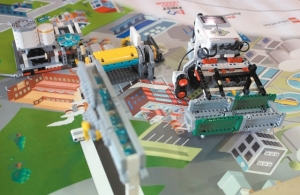A solution and a contract
By Steve Herring
Published in News on February 20, 2018 9:52 PM

News-Argus/CASEY MOZINGO
Raelee Boren, 11, and Jacob Cerney, 11, begin running their mission using the team's Lego robot Monday during a 4-H Robo Recruits meeting at the Wayne Center.

News-Argus/CASEY MOZINGO
Daniel Boren, 13, and Elijah Lee, 12, send the robot built by the Robo Recruits on a mission to collect Lego water droplets. The team may only have two members at the table at one time so their teammates wait nearby for their turn.

News-Argus/CASEY MOZINGO
The six-member team was excited.
Duke Energy had responded to its letter proposing a way to safely remove coal ash contaminants from the soil and groundwater.
But the excitement was mixed with surprise. The energy giant's response included an application for becoming a potential contractor.
Unfortunately they had to decline -- they do not have a contractor's license and after all, they are only 10 to 14 years of age.
"They gave us a job application for a contractor" said Gabriel Romero, 14, a member of the 4-H Robo Recruits of the FIRST LEGO League #27060. "But we don't do that, though we could use the money."
That's right, to buy needed equipment like a laptop and more robots to build more teams, adult leader Chasity Cerny said.
"They are not joking," Cerny said. "They sent them the paperwork for contractors. We didn't know what to do with that. They had to write them back and highlight that they said they were 10 to 14 years old and don't have a contractor's license."
Gabriel, Raelee Boren, who penned the letter to Duke, Daniel Boren, Jacob Cerny, Elijah Lee and Nicholas Casey make up the team.
The team is a member of the league that is a joint venture between FIRST (For Inspiration and Recognition of Science and Technology) and LEGO.
It is open to elementary and middle school-aged students who research a real-world engineering challenge, develop a solution and compete with LEGO-based robots of their own design.
Members apply science, engineering and math concepts, plus a healthy amount of imagination, to develop solutions to real-world challenges.
They also design, build and program LEGO Mindstorms-based robots to perform autonomous "missions" on a playing field. Along the way, they develop critical thinking, team-building, and presentation skills.
The youths wrote to Duke after competing on the regional and state levels of this year's statewide theme of hydrodynamics -- the physics behind getting water safely to communities.
In their letter they suggested that Duke add their solution to its current efforts to reduce coal ash contaminants.
They wrote, "Our research has led us to select both hydroponics and phytoremediation as a cost effective and environmentally friendly way to reduce the heavy metal contaminants in coal ash in water and soil."
Hydroponics uses water-based plants, such as duckweed and water lilies, to filter contaminants from water.
Phytoremediation uses quick-growing trees, such as poplar and willows, to filter the contaminated soil. The roots transfer the contaminants through the tree and into the leaves.
The trees can then be harvested and burned or the metals can be extracted and recycled.
"We hope that businesses such as Duke Energy will find this information helpful and challenge them to implement our recommendation," the team wrote.
"We had this idea because it is one of our major water pollution problems," said Gabriel, who at age 14 is aging out of the group this year. "It is worldwide. It is everywhere."
There is even one in Goldsboro, the H.F. Lee Plant, he said.
The team came together, making heavy use of Google, to research the issue and develop the idea of using plants, Gabriel said.
"We thought that if we could write a report and share with the world, that we could come up with an idea to take the contaminants out of the water and that it would help," he said.
Also, water was the theme this year, Daniel said. Last year, the theme was animal allies. At age 13, Daniel is also aging out this year.
"So each year there is a new theme," Cerny said. "The theme does not just affect the way that we program (robots), but also asks what the problem is and what our solution is so that each year, we cannot use the same project. It is a way to make it a lot more challenging.
"Apparently their idea is going to be done, but I don't know to what scale because the next day, after they competed at state, I ran across an article about an artist with a picture of lilies. It looked like a watercolor."
The article said she was working to get a grant from North Carolina A&T State University to plant lilies.
The idea could work, and is not a new one, but it is new to this capacity, Cerny said.
On the robotic side of the program, the team also received an honor for its robot for its simplicity and accuracy and the use of a design element by Elijah Lee.
"They had one attachment and instead of taking it off when it comes back to the base, because it is a timed event, he grabbed the other attachment and put it on," Cerny said.
"So it was easier to do than taking it off and putting on another," Elijah said. "You just have to add it on. So it is simple."
It was a time saver, Cerny said.
There is more to the program than building robots, she said.
There are core values, which are more about teammates and how the students work with each other, she said.
The members have independent work, but have collaborative work as well.
"They learn and they grow in different ways," Cerny said. "It is not just the robot gaming for them to be able to do all of this research and everything. I am very proud of these guys. They saw three judges before lunch and did great."
Cerny said she also wants members to be kids and have fun.
Once the robot building is completed the children learn about the business end of the project and do outreach projects such as last year when they build birdhouses for the public library, she said.
Raelee ran the business side for this year's project and wrote many of the letters.
Other projects include helping with trash pickup or providing soup to a soup kitchen.
The club is in its second year and normally meets once a week, but during the competition season it will meet twice a week.
Cerny said the plan is to expand the local program.
"When we make it larger we can include more teams," she said. "You can only have 10 kids max per team, and then we could serve more in the area. What I saw them do was great, and I want to see other kids do it."
Part of that plan is to secure nonprofit status and search for a building in which to meet. They currently meet in the Wayne Center, but that building is expected to be demolished once the Maxwell Regional Agricultural and Convention Center is fully operational.
The club already has a charter and would operate as a STEM (Science, Technology, Engineering and Math) club and spin off different clubs that would open to all youths, she said.
Fundraisers would be held and members would pay dues to help cover the costs, Cerny said.
Any funds remaining at the end of the season would be used to buy equipment.
"We would like to go into the next season buying equipment because we need a laptop for them and a space because we want to make more teams," she said.
The county library is going to let the team use its facilities for program training, Cerny said.
"We did it last year and it worked out pretty good, and they all learned a lot," she said. "But we have more kids this year, and we want to teach them."
